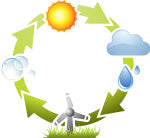You are probably be familiar with the water cycle (technically known as the hydrological cycle), do you know what it can do to help us from its continuous movement of water over, above, and beneath the Earth's surface. As water moves around in the hydrosphere, it changes state among liquid, vapor, and ice. During the process through which a liquid becomes a vapor, it is defined as Evaporation.
When the air cools, the water vapor condenses in the clouds and falls to the earth it hits the ground and is absorbed in many ways. It can be absorbed by plants, stored on the surface in a lake, stream, ocean, or evaporated by the sun. It can also be absorbed into the soil or pulled through the soil for years as groundwater. The water used by plants can go back into the earth by transpiration. Transpiration is the process by which moisture is carried through plants from roots to small pores on the underside of leaves, where it changes to vapor and is released into the atmosphere. You are probably thinking, how is this possible? I don’t see plants sweating! Just because you can’t see the water doesn’t mean it is not being brought to the air. During a growing season, a leaf will transpire many times more water than its own weight. For example, a large oak tree can transpire 40,000 gallons of water per year!
Minerals like salt and other substances dissolved in water are left behind. As a result, when the water vapor condenses to become water again, it is relatively pure. The evaporation and condensation are the key terms that help water purifying. While these processes occur during the water cycle, it can also be used to purify water for drinking or industry use. Water is always moving. The movement is driven by the energy of the sun and the force of gravity. Here, a simple experiment that you can do at home, it will help you understand how the water cycle helps to purify water.

MATERIALS NEEDED:
- 4 cups of dirt or sand
- 12 stones
- 2 quarts of water
- Large glass bowl with tall sides (mixing bowl)
- A short glass
- Clear plastic wrap
- A sunny day
PROCEDURE:
Mix the dirt (or sand) and water in a large bowl. Stand a clean and empty short glass in the center of the bowl. Place the bowl outside in the sun. Cover the bowl with the plastic wrap and weigh down the edges with the remaining rocks. Place one rock on the plastic wrap directly over the cup. Allow the bowl to remain in the sun for several hours. Look in the cup (it should contain some relatively clean water free of mud). Look in the bowl (it should contain the dried dirt).
FOLLOW-UP QUESTIONS:
- What are the two processes responsible for purifying the water? (Evaporation and Condensation)
- Where else do you see condensation? (Cold drink outside on a hot day)
- How does this process work on Earth?
- What is the plastic wrap? (Our atmosphere)
- What is the condensation? (Clouds and rain)
- What would happen if the plastic wrap was dirty? (Air pollution)
VARIATIONS: Add food coloring to water to demonstrate that this process does not remove all pollutants. This may be done simultaneously with the procedure above.
Source: Environmental Protection Agency



